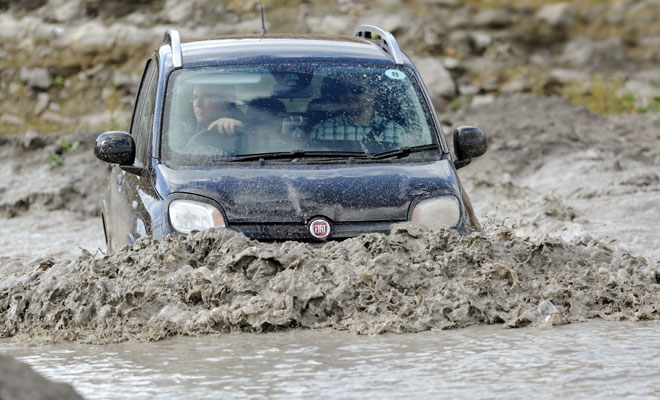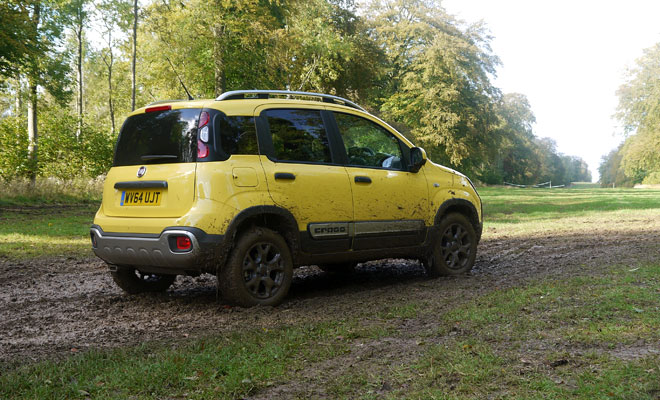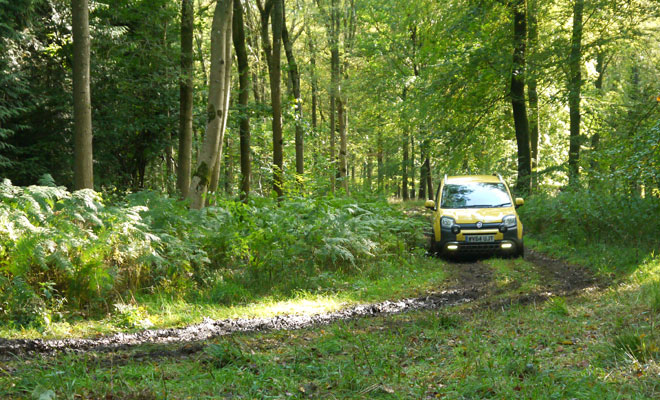by Lem Bingley 
As I’m about to set off, a marshal in a high-vis vest leans through the window to tell me what to watch out for. Mainly it’s the water – don’t go so fast that the bow-wave crests the bonnet, he tells me sternly. The Panda Cross has an elevated air-intake so it can breathe while fording, but it’s not a submarine.
I notice that the instructor has arrived by Land Rover, so I ask if he’s brought it along to haul me out if I get stuck. He shakes his head and tells me the course is too wet for a full-size 4x4 – the Landie would sink up to its axles and sit there digging holes, he reckons, adding that the little Fiat will be fine. I look around and begin to wish I’d worn wellies. Or waders.

Worries quickly prove misplaced. The Panda romps through the water like a Labrador after a stick. I’m almost surprised it doesn’t shimmy itself dry as we clamber out at the other end.
The Panda Cross is a development of the existing Panda 4x4, which itself is capable of negotiating routes that look nothing like a road. It provides the basic capability – permanent four-wheel-drive that on tarmac will send only two percent of torque to the back axle. But in slippery situations an electro-hydraulic centre differential can split the drive between the axles, sending everything to the back end if needed. And by selectively braking any uselessly spinning wheels, power is diverted to whichever tyres have purchase.

Steel skid plates protect the car’s underbelly, allowing it to crawl over rocks without leaving pools of vital fluids in its wake. I’m glad of this, having smacked the Panda down a few times already.
To this basic formula the Cross adds a toughened exterior – reshaped bumpers less likely to scrape a steep slope front and rear, plus bash-proof plastic around the lamps. More importantly, the Cross formula mixes in revised springs, chunkier mud-and-snow tyres on wider 15-inch alloys, slightly more ground clearance, and a Terrain Control dial that includes off-road and hill-descent modes.

The latter is a boon in the scary business of heading downhill on what feels like a ski slope surfaced with sludge. Rotate the terrain dial, lurking down between the front seats, until the green hill descent light comes on. Then creep over the crest, take your feet of the pedals, and steer for whatever looks as if it might offer a bit of grip. You can even put the car in neutral – which feels distinctly surreal – and the Panda Cross will chug slowly all the way to the bottom and then stop.
I’m not entirely sure about the wisdom of that last feature. Gliding along in neutral is generally a bad idea on the road and even worse off of it. And worryingly, if you apply the handbrake even for a second, Fiat’s hill descent mode will merrily switch itself off. I don’t understand the logic behind that decision, given that a steep slope, hill mode accidentally off and neutral gearing sounds a little scary to me. Fortunately, the Panda Cross will happily descend slopes in first gear, which is where I’d be inclined to leave it all the way down.

After a quick hose down, we leave the quarry and head out onto tarmac, where surprisingly the Panda Cross does not embarrass itself. The car does lean and sway through corners but its all-weather tyres keep clinging onto the tarmac with surprising vigour, helped by the Panda Cross’s ability to send drive to the back axle rather than simply flailing into understeer.
Handling and ride comfort are more than adequate for a compact city car or 4x4, or indeed both rolled into one. Unsporty styling means good all-round vision through big windows, which is handy both on and off road. Refinement is a topic I’d best steer clear of, however. Bring earplugs for long journeys.

Front row seating feels comfortable, and there’s reasonable room in the rear too. The seats do force you into a fairly upright posture – more dining chair than sprawling sofa.
The Panda Cross gets its own upholstery, featuring natural fibres and eco-leather bolsters that combine to give a Barbour-ish outdoorsy feel. The rest of the interior is familiar Panda – which means tough, hard plastics and a repeated motif of soft-cornered squares called “squircles”. Mostly the squircular theme is attractive and charming, though the squarish instruments can be a little hard to read.
The steering wheel has a very chunky leather-bound rim but feels surprisingly light to twirl (lighter still in city mode). It manages to provide a decent amount of feel by modern standards – on the road at least. Off-road, in soggy conditions, the wheel can feel like it’s connected to a rudder rather than a pair of driven wheels.
The steering wheel does adjust for rake but not for reach, and I find myself sitting gorilla fashion – if you have long arms and short legs you’ll find it easy to get comfortable, otherwise you may struggle.

Two versions of the Panda Cross are available, a petrol and diesel.
My favourite is the petrol, powered by Fiat’s 875cc turbocharged two-cylinder TwinAir engine. It provides a maximum of 90bhp at 5,500rpm – five horsepower more than the same engine in other Pandas – and up to 145Nm of torque. With a kerb weight of 1,090kg the TwinAir Panda Cross can scamper to 62mph in 12 seconds dead, and earns a combined cycle score of 57.6mpg and a 114g/km CO2 rating.
The TwinAir edition feels surprisingly keen and eager, sufficient to instil enough confidence to overtake a dawdling Nissan Micra on a twisty B-road.
The petrol Panda features stop-start technology to save fuel, and the centre of the instrument panel provides gearshift hints. It’s a good idea to follow these if you aim to approach the official rating, as the TwinAir’s unusual sound makes it hard to judge the right moment to change up by ear alone. I keep bouncing off the rev limiter while my senses adjust to its loud, motorcycle thrum, which is hardly conducive to economy. Even so, the trip meter says I’m getting 40mpg or so on the road.

The petrol engine comes paired with a six-speed gearbox that includes a “crawler” first gear to help the Panda Cross climb steep off-road slopes. Although a good run-up, second gear and a floored throttle seems to do the trick too.
The 1.3-litre MultiJet diesel, meanwhile, comes with a five-speed gearbox but could really use a sixth slot for more relaxed motorway cruising. Its booming drone quickly gets tiresome on the road. The diesel is also slower to 62mph – needing 14.3 seconds – as well as 65kg heavier than the TwinAir at 1,155kg. Peak power is 80bhp (again, 5bhp more than the same engine in other Pandas) while top torque is 190Nm. It turns in an economy score of 60.1mpg and 125g/km in CO2 terms.
The diesel is also a noticeable £1,000 more than the petrol Panda Cross. The TwinAir starts at £15,945 while the MultiJet costs from £16,945. The premium for either Panda Cross over the equivalent Panda 4x4, meanwhile, is a relatively steep £1,700.

The ordinary Fiat Panda 4x4 is a very likeable, very capable car. It can laugh in the face of tough terrain and then quietly potter to the shops, and will cope with most things thrown at it by the British weather. The Panda Cross does much more of the same, with its terrain dial turning the little Fiat’s off-road capability up to 11.
Whether you need that extra capability, and want to pay a big premium for it, will probably depend on where you live. If your house can be found perched at the summit of a mountain crag, lies at the end of a steep and muddy goat track, or sits isolated on an eyot in the middle of a river, I can’t recommend the Panda Cross highly enough. For the rest of us, the standard Panda 4x4 is probably all the off-road runabout we’ll ever need.


Fiat Panda Cross
Rating: stars
Good: huge off-road capability, not bad on tarmac
Bad: not quiet, big price hike over Panda 4x4
Price: from £15,945
Today I’ve borrowed the keys to a Panda Cross, a sturdy new off-road edition of Fiat’s boxy city car. Fiat itself has been much more ambitious in its borrowing, taking over an entire Cotswolds quarry. The bulldozers and diggers that normally lumber about excavating chunks of limestone are standing idle, having first arranged tonnes of earth into a kind of a road for us – albeit one made of mud, rocks and gravel, chock full of lumps, bumps and potholes, and with slopes steep enough to give a pigeon vertigo. And it’s been raining, meaning the lower portions have become a river the colour of concrete. Rating: stars
Good: huge off-road capability, not bad on tarmac
Bad: not quiet, big price hike over Panda 4x4
Price: from £15,945
As I’m about to set off, a marshal in a high-vis vest leans through the window to tell me what to watch out for. Mainly it’s the water – don’t go so fast that the bow-wave crests the bonnet, he tells me sternly. The Panda Cross has an elevated air-intake so it can breathe while fording, but it’s not a submarine.
I notice that the instructor has arrived by Land Rover, so I ask if he’s brought it along to haul me out if I get stuck. He shakes his head and tells me the course is too wet for a full-size 4x4 – the Landie would sink up to its axles and sit there digging holes, he reckons, adding that the little Fiat will be fine. I look around and begin to wish I’d worn wellies. Or waders.

Worries quickly prove misplaced. The Panda romps through the water like a Labrador after a stick. I’m almost surprised it doesn’t shimmy itself dry as we clamber out at the other end.
The Panda Cross is a development of the existing Panda 4x4, which itself is capable of negotiating routes that look nothing like a road. It provides the basic capability – permanent four-wheel-drive that on tarmac will send only two percent of torque to the back axle. But in slippery situations an electro-hydraulic centre differential can split the drive between the axles, sending everything to the back end if needed. And by selectively braking any uselessly spinning wheels, power is diverted to whichever tyres have purchase.

Steel skid plates protect the car’s underbelly, allowing it to crawl over rocks without leaving pools of vital fluids in its wake. I’m glad of this, having smacked the Panda down a few times already.
To this basic formula the Cross adds a toughened exterior – reshaped bumpers less likely to scrape a steep slope front and rear, plus bash-proof plastic around the lamps. More importantly, the Cross formula mixes in revised springs, chunkier mud-and-snow tyres on wider 15-inch alloys, slightly more ground clearance, and a Terrain Control dial that includes off-road and hill-descent modes.

The latter is a boon in the scary business of heading downhill on what feels like a ski slope surfaced with sludge. Rotate the terrain dial, lurking down between the front seats, until the green hill descent light comes on. Then creep over the crest, take your feet of the pedals, and steer for whatever looks as if it might offer a bit of grip. You can even put the car in neutral – which feels distinctly surreal – and the Panda Cross will chug slowly all the way to the bottom and then stop.
I’m not entirely sure about the wisdom of that last feature. Gliding along in neutral is generally a bad idea on the road and even worse off of it. And worryingly, if you apply the handbrake even for a second, Fiat’s hill descent mode will merrily switch itself off. I don’t understand the logic behind that decision, given that a steep slope, hill mode accidentally off and neutral gearing sounds a little scary to me. Fortunately, the Panda Cross will happily descend slopes in first gear, which is where I’d be inclined to leave it all the way down.

After a quick hose down, we leave the quarry and head out onto tarmac, where surprisingly the Panda Cross does not embarrass itself. The car does lean and sway through corners but its all-weather tyres keep clinging onto the tarmac with surprising vigour, helped by the Panda Cross’s ability to send drive to the back axle rather than simply flailing into understeer.
Handling and ride comfort are more than adequate for a compact city car or 4x4, or indeed both rolled into one. Unsporty styling means good all-round vision through big windows, which is handy both on and off road. Refinement is a topic I’d best steer clear of, however. Bring earplugs for long journeys.

Front row seating feels comfortable, and there’s reasonable room in the rear too. The seats do force you into a fairly upright posture – more dining chair than sprawling sofa.
The Panda Cross gets its own upholstery, featuring natural fibres and eco-leather bolsters that combine to give a Barbour-ish outdoorsy feel. The rest of the interior is familiar Panda – which means tough, hard plastics and a repeated motif of soft-cornered squares called “squircles”. Mostly the squircular theme is attractive and charming, though the squarish instruments can be a little hard to read.
The steering wheel has a very chunky leather-bound rim but feels surprisingly light to twirl (lighter still in city mode). It manages to provide a decent amount of feel by modern standards – on the road at least. Off-road, in soggy conditions, the wheel can feel like it’s connected to a rudder rather than a pair of driven wheels.
The steering wheel does adjust for rake but not for reach, and I find myself sitting gorilla fashion – if you have long arms and short legs you’ll find it easy to get comfortable, otherwise you may struggle.

Two versions of the Panda Cross are available, a petrol and diesel.
My favourite is the petrol, powered by Fiat’s 875cc turbocharged two-cylinder TwinAir engine. It provides a maximum of 90bhp at 5,500rpm – five horsepower more than the same engine in other Pandas – and up to 145Nm of torque. With a kerb weight of 1,090kg the TwinAir Panda Cross can scamper to 62mph in 12 seconds dead, and earns a combined cycle score of 57.6mpg and a 114g/km CO2 rating.
The TwinAir edition feels surprisingly keen and eager, sufficient to instil enough confidence to overtake a dawdling Nissan Micra on a twisty B-road.
The petrol Panda features stop-start technology to save fuel, and the centre of the instrument panel provides gearshift hints. It’s a good idea to follow these if you aim to approach the official rating, as the TwinAir’s unusual sound makes it hard to judge the right moment to change up by ear alone. I keep bouncing off the rev limiter while my senses adjust to its loud, motorcycle thrum, which is hardly conducive to economy. Even so, the trip meter says I’m getting 40mpg or so on the road.

The petrol engine comes paired with a six-speed gearbox that includes a “crawler” first gear to help the Panda Cross climb steep off-road slopes. Although a good run-up, second gear and a floored throttle seems to do the trick too.
The 1.3-litre MultiJet diesel, meanwhile, comes with a five-speed gearbox but could really use a sixth slot for more relaxed motorway cruising. Its booming drone quickly gets tiresome on the road. The diesel is also slower to 62mph – needing 14.3 seconds – as well as 65kg heavier than the TwinAir at 1,155kg. Peak power is 80bhp (again, 5bhp more than the same engine in other Pandas) while top torque is 190Nm. It turns in an economy score of 60.1mpg and 125g/km in CO2 terms.
The diesel is also a noticeable £1,000 more than the petrol Panda Cross. The TwinAir starts at £15,945 while the MultiJet costs from £16,945. The premium for either Panda Cross over the equivalent Panda 4x4, meanwhile, is a relatively steep £1,700.

The ordinary Fiat Panda 4x4 is a very likeable, very capable car. It can laugh in the face of tough terrain and then quietly potter to the shops, and will cope with most things thrown at it by the British weather. The Panda Cross does much more of the same, with its terrain dial turning the little Fiat’s off-road capability up to 11.
Whether you need that extra capability, and want to pay a big premium for it, will probably depend on where you live. If your house can be found perched at the summit of a mountain crag, lies at the end of a steep and muddy goat track, or sits isolated on an eyot in the middle of a river, I can’t recommend the Panda Cross highly enough. For the rest of us, the standard Panda 4x4 is probably all the off-road runabout we’ll ever need.




